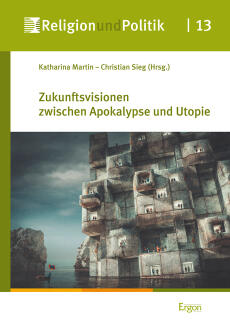Visions of the Future between Apocalypse and Utopia

Envisioning the future is a fundamental political act, since it always expresses a critical stance towards the current society. In addition, visions of the future form a contrast to the present which highlights the very insufficiency of today’s state of affairs. The book shows that apocalypse and utopia are two historically significant visions of the future which created images and narratives that persist until today. The shining Heavenly Jerusalem or the perfection of utopian communities stresses the downside of the present – thereby generating political pressure. The fictitious account of the island Utopia with its ideal social conditions, which English statesman and author Thomas More (1475-1535) published, aimed at criticizing the conditions in Europe at that time.
At any time, utopias have served as alternative models to contemporary societies. This political angle is of utmost importance for the apocalypse as well: On the one hand, apocalyptic visions depict the present hardship in drastic terms and show how it will inevitably result in the end of the world. On the other hand, the end of the world becomes the beginning of a new, better age, the Heavenly Jerusalem. Early examples are the accounts in the New Testament such as the Apocalypse of John, that imagines salvation as a comfort to the oppressed Christians in the Roman Empire.
The book focuses on historical and contemporary instances of apocalyptic and utopian thought. The introduction by Christian Sieg and two contributions by Klaus Vondung and by Andreas Urs Sommer introduce the two basic concepts. While many contributions of the past decades have located apocalyptic and utopian thought in close proximity, Vondung and Sommer analyze the imagination of the future either in apocalyptic or in utopian terms, thereby stressing the difference of both genres. The following chapters trace the history of apocalyptic thought: Joachim Friedrich Quack focuses on prophecy in Old Egypt, Jay Rubenstein analyses the First Crusade, which was justified as a Biblical eschatological battle, Matthias Riedl explains Joachim of Fiore’s apocalyptic visions of the future, and Maren Conrad takes a look at the variations of apocalyptic narratives in contemporary culture, as to be found in literature, movies and computer games.
The last four contributions of the volume take recourse to visions of the future that might be characterized as utopian. Katharina Martin follows the vision of the Golden Age and its iconic reflection on coins of the Roman Empire. Toni Morant i Ariño focuses on the ways in which the female movement of the Falange Española employs utopian as well as apocalyptic ideas. Josef Früchtl analyses the conditions and narratives of utopian drafts after the end of postmodernity by examining the two movies Avatar (2009) and Cloud Atlas (2012). Finally, Tatjana Hörnle shows that views into the future are of importance for the legal discourse as well.

